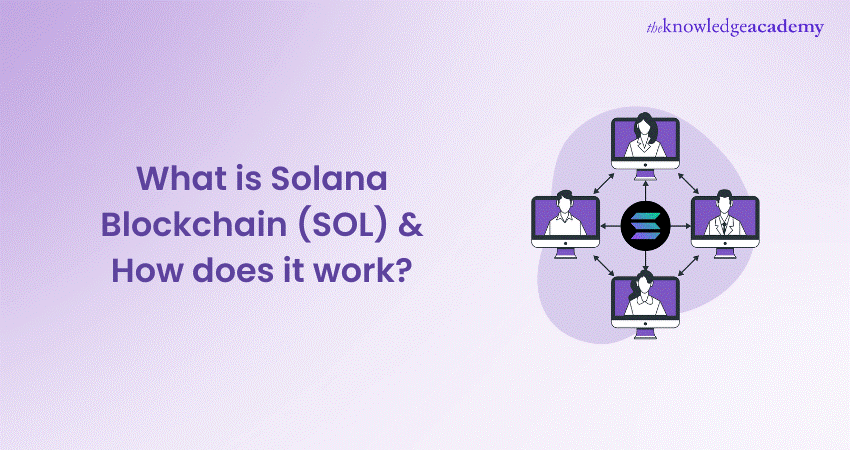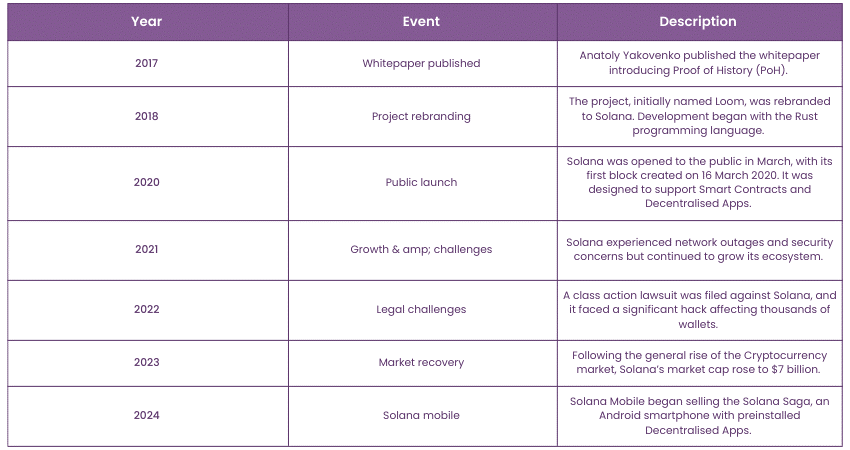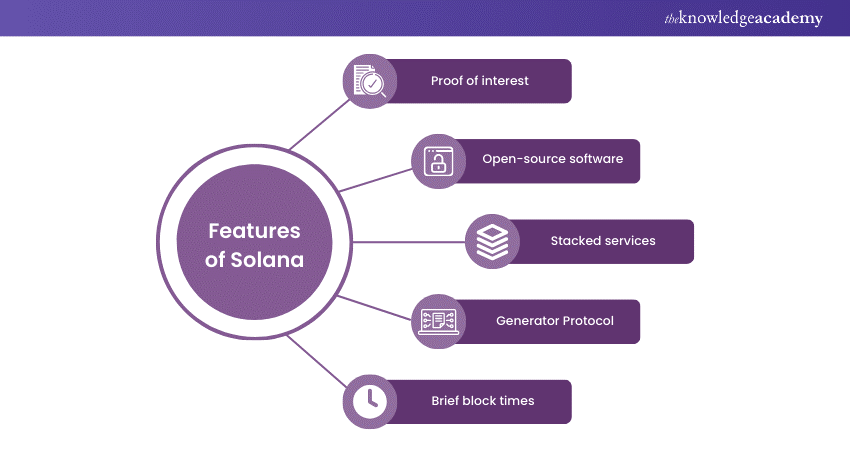We may not have the course you’re looking for. If you enquire or give us a call on 01344203999 and speak to our training experts, we may still be able to help with your training requirements.
Training Outcomes Within Your Budget!
We ensure quality, budget-alignment, and timely delivery by our expert instructors.

The Solana (SOL) Blockchain is making waves with its super-fast speeds and low costs, changing how we think about online transactions. It’s built for quick and cheap use, perfect for developers who want to create smooth-running apps.
Cryptocurrency is a digital asset which can be used for exchange without being controlled by a bank or government. Forbes Advisor estimates that there are 22,088 Cryptocurrency projects operating now, which together account for the whole £672 billion Cryptocurrency market.
Solana Blockchain meets users' requests for platforms with quicker and less expensive transactions.
As a result, users are switching to Solana at an ever-increasing rate as new integrations are added. So, in this blog, we’ll talk about everything you need to enter in the Solana ecosystem. Get ready to gain expertise in what Solana Blockchain is, how it works, the SOL token and much more!
Table of Contents
1) What is Solana (SOL)?
2) History of Solana
3) How does Solana work?
4) Features of Solana
5) What makes Solana Blockchain unique?
6) How to begin making investments in Solana?
7) Solana use cases
8) Solana vs Ethereum
9) Conclusion
What is Solana (SOL)?
The Solana company was created in 2017. This Blockchain platform serves exclusively for the creation of applications that are decentralised and scalable with an open network in nature. This non-profit organisation was founded by the Solana Foundation and headquartered in Geneve. Its Blockchain infrastructure is crafted by Solana Labs from San Francisco.
Solana is known to be very fast in transaction speed and charges less in terms of fees, at times levelled with Ethereum or even much lower. Its native Cryptocurrency, SOL, was up by around 12,000% in the year 2021 and at some point had its market cap at a value of more than £75 billion, therefore being among the largest Cryptocurrencies in the world.
Solana is known for the best transaction speeds, and its fees compare extremely favourably to those of competing chains, including Ethereum. In fact, the biggest Solana con is the native Cryptocurrency on the Solana network, namely Solana (SOL), which surged to nearly 12,000% in 2021—flirting even with a market cap north of £75 billion—among leading Cryptocurrencies.
Still, SOL was not completely immune to the devastating Crypto market crash of 2022. By the end of that year, its market capitalisation fell to around £3.63 billion. But some light was visible at the end of the tunnel: in the next year, SOL was to regain almost half of its value.
History of Solana
Solana stands out in the Blockchain universe with its unparalleled speed and efficiency. It's a platform where developers can build Crypto apps that work and thrive; with its cutting-edge technology, Solana offers a seamless experience for users and creators alike.
The journey of Solana started in late 2017 when Antony Yakovenko, a man with a background in distributed systems from his time at Qualcomm, Mesosphere, and Dropbox, introduced the world to Proof of History (PoH), a method for keeping time between computers that don't trust each other.
The initial implementation of Yahenko's idea began in a private codebase in C, but Greg Fitzgerald suggested reimplementing the project in Rust for its safety guarantees and performance. Initially named Loom, the project was published on GitHub under the name Silk. The first open-source implementation demonstrated the ability to process thousands of transactions in just over half a second.
For a while, the team was confused with another project named Loom, which was also Ethereum-based, and as a result, they had to rename it to Solana, which later was a tribute to Solana Beach, where the founders used to surf.
Solana has been a Smart Contract platform and Decentralised Application support since March 2020. It was intended to cope with many transactions per second, which became a scalability problem for earlier Blockchains like Bitcoin and Ethereum.
However, Solana’s journey has not been without challenges. The Blockchain has experienced a couple of network failures, a serious hack, and legal issues, including a lawsuit for allegedly selling unregistered securities and untrue statements about the number of tokens. Despite these setbacks, Solana has continued to grow, with its market cap reaching $7 billion in 2023 following the general rise of the Cryptocurrency market.

Learn how bitcoins work and how to secure bitcoins. Register for our Bitcoin and Cryptocurrency Course now!
How does Solana work?
Proof-of-Stake (PoS) and Proof-of-History (PoH) methods are combined to power Solana. These algorithms stand in stark contrast to the Proof-of-Work (PoW) techniques employed by networks like Bitcoin.
To add blocks and transactions to the Blockchain, PoW forces computers to compete with one another to solve challenging riddles. Because of how difficult these problems are to answer and how much computer power is needed, they use an enormous amount of energy. Solana takes these conundrums out of the equation. As a result, it has far higher TPS performance and doesn't lead to the same level of environmental deterioration.
Features of Solana
Fourth-generation Blockchain Solana has all the recognition of its early pioneers as well as a few extra functions. These additional features allow it to do rapid transactions in a flexible way. The features of Solana are listed below.

1) Proof of interest
Similar to Blockchains like Ethereum, Solana enables users to stake SOL tokens, which helps to process transactions more quickly and effectively. Users can vote for Blockchain modifications proposed by members of the Solana Developer community using the staking process.
2) Open-source software
Solana features an open-source application, as many other Blockchains do. Anyone can use the source code for both personal and business purposes by downloading it.
3) Stacked services
To increase productivity, Solana employs a number of services on top of the network. It is one such technology where different layers conduct a particular function.
4) Generator protocol
Solana transmits information to neighbourhood node clusters, which are close by, using the Generator protocol in smaller pockets. This makes it possible for it to validate transactions more quickly.
5) Brief block times
Solana has a block time of 400ms. Transactions are processed quickly and may easily process thousands of transactions per second due to short block periods.
What makes Solana Blockchain unique?
Solana differentiates itself in the Blockchain world by its inventive approach to tackling the Blockchain trilemma—decentralisation, security, and scalability.
Proof of History (PoH)
Proof of History (PoH) is one of Solana's unique techniques that makes it possible to achieve high throughput. It operates by providing documentary evidence that a particular incident took place at a particular time and space. This represents a shift from conventional consensus mechanisms, including Proof of Work (PoW) and Proof of Stake (PoS), where validators are required to agree on transaction ordering. PoH is also more efficient because validators can process transactions on their own without having to wait for a consensus on the transaction order.
Validator voting
In Solana, validators take part in the consensus mechanism by voting on the state of the ledger. This process is made more efficient by PoH, as validators are given a verifiable way of knowing the time between events, which reduces the need for communication between all the nodes. Such a mechanism enables the achievement of high-speed transmission and a level of decentralisation.
Hybrid consensus model
The Proof-of-History (PoH) consensus model of Solana incorporates a delegated Proof-of-Stake (dPoS) system. In this model, token holders can choose to delegate their stake to validators who secure the network. A fusion of PoH and dPoS is what makes Solana a network with fast transaction throughput that is still resistant to control by any single entity.
Transactional chain
The transactional chain in Solana is a sequential computation of the outputs from one transaction that serve as the inputs for the following transaction. Besides this, it is a core part of PoH that a chain of transactions is created, and a verifiable order of events without the need for a centralised clock is created. This framework plays a crucial role in Solana's scalability since it allows the network to process more transactions.
Interoperability
Solana is designed to be interoperable with other Blockchains and other applications. Its architecture is the backbone of digital assets such as Cryptocurrencies, NFTs and personalised data exchange. Such interoperability is vital to the acceptance of Solana, as it allows seamless integration with the wider Crypto-ecosystem.
Rapid transaction rates
Perhaps the most popular feature of Solana is its ability to process transactions at really high speeds. With block times as short as 400 milliseconds, Solana can handle up to 65,000 transactions per second. This speed makes it a viable competitor to traditional payment systems and enables real-time application execution.
Censorship resistance
To combat censorship, Solana employs a network of rotating validator nodes. This design ensures that no single validator can control which transactions are included in the Blockchain. Additionally, Solana uses algorithms to determine the minimum number of compromised nodes required to affect each validator, further enhancing the network’s resistance to censorship.
Refer to these Blockchain Interview Questions and Answers to crack your next job interview!
How to begin making investments in Solana?
Buying some SOL tokens and transferring them to a Solana wallet like Phantom is the first step in getting started with the Solana network. Start by transferring some money to FTX, buying SOL tokens there, and then transferring those tokens directly to the Phantom wallet. However, it should be emphasised that only FTX permits direct fund withdrawals to Solana; other exchanges do not.
Learn the fundamentals of Blockchain 101 and Ethereum. Sign up for our Ethereum Developer Training now!
Solana use cases
Several Blockchain Projects use Solana's flexibility and adaptability. Developers have put Blockchain to innovative use. Some of its use cases are listed below:
1) Decentralised Applications
Solana is a Blockchain platform for Smart Contracts, similar to Ethereum. This indicates that it encourages the creation of Decentralised Applications, or dApps, which have a variety of applications. Simple web apps to complex Decentralised Finance (DeFi) apps can all be built on Smart Contracts Blockchains; nevertheless, establishing DeFi and NFT app platforms has been Solana's primary use cases as developers continue to look for more affordable and scalable platforms.
2) Lending protocols
A few programmers have developed systems that enable users to deposit or lend money over the Solana Blockchain. Users have the option to set up automated repayments or earn interest. Solend and Apricot Finance are two examples.
3) Non-fungible Tokens (NFTS)
NFTs are the digital equivalent of almost anything like music, photos, video clips, and so on, to be more precise. The distinguishing feature of NFTs is that they are "non-fungible" in the sense that each object has a unique identifier containing ownership data. Moreover, Solana is interested in building NFT marketplaces where the NFTs will be sold. The Solana network is expected to be one of the best NFT platforms and not congested, even though there aren't quite many Solana-based NFT markets.
Solana vs Ethereum
Solana's rapidly expanding ecosystem and versatility have inevitably drawn comparisons to Ethereum, the leading Blockchain for Decentralised Applications (dApps):
a) Smart contracts: The Solana and Ethereum platforms are Smart Contract-backed. These are valuable tools that help develop applications such as Decentralised Finance (DeFi) and Non-Fungible Assets (NFTs).
b) Consensus: Solana and Ethereum use this technique. Validators stake their money as collateral for the right to receive rewards for advancing the Blockchain. By integrating PoH as well, Solana enhances PoS.
c) Speed: In 2021, Solana generated significant attention because it outperformed Ethereum in terms of transaction fees and processing times. Solana has a maximum TPS processing capacity of 50,000 and an average cost per transaction of £0.00021. Ethereum, in contrast, has a TPS limit of fewer than 15 and average transaction costs of £1.39.
Learn to create and deploy your Private Blockchain on Multichain. Check out our Blockchain Training today!
Conclusion
Solana Blockchain is a game-changer, offering a fast, secure, and scalable platform for the future of Decentralised Applications. Its innovative design allows for rapid transactions with minimal fees, making it an attractive choice for developers and users. As we embrace this technology, Solana could be the cornerstone of a new, decentralised internet era.
Frequently Asked Questions

Solana has fast transactions and low costs, which makes it an option for specific apps. Nevertheless, Ethereum has a more evolved ecosystem and higher decentralisation. The decision depends on the application area; Ethereum is strong in the security and developer community, while Solana is fast and cheap.

Despite facing challenges, Solana continues to evolve with a focus on mobile integration and network reliability. Predictions suggest a positive outlook, with potential growth in value and adoption. Its future depends on overcoming technical hurdles and market competition.

The Knowledge Academy takes global learning to new heights, offering over 30,000 online courses across 490+ locations in 220 countries. This expansive reach ensures accessibility and convenience for learners worldwide.
Alongside our diverse Online Course Catalogue, encompassing 17 major categories, we go the extra mile by providing a plethora of free educational Online Resources like News updates, Blogs, videos, webinars, and interview questions. Tailoring learning experiences further, professionals can maximise value with customisable Course Bundles of TKA.

The Knowledge Academy’s Knowledge Pass, a prepaid voucher, adds another layer of flexibility, allowing course bookings over a 12-month period. Join us on a journey where education knows no bounds.

The Knowledge Academy offers various Blockchain Training, including Bitcoin and Cryptocurrency Course, Ethereum Developer Training and many more. These courses cater to different skill levels, providing comprehensive insights into Blockchain Developer Skills.
Our Advanced Technology Blogs cover a range of topics related to Blockchain, offering valuable resources, best practices, and industry insights. Whether you are a beginner or looking to advance your knowledge on Blockchain, The Knowledge Academy's diverse courses and informative blogs have you covered.
Upcoming Programming & DevOps Resources Batches & Dates
Date
 Blockchain Training Course
Blockchain Training Course
Thu 11th Jul 2024
Thu 19th Dec 2024







 Top Rated Course
Top Rated Course



 If you wish to make any changes to your course, please
If you wish to make any changes to your course, please


